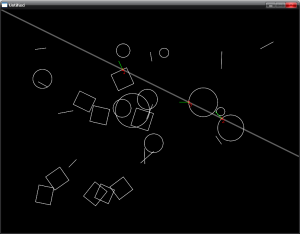World:rayCast
| Available since LÖVE 0.8.0 |
| This method is not supported in earlier versions. |
Casts a ray and calls a function for each fixtures it intersects.
Contents
Function
Synopsis
World:rayCast( x1, y1, x2, y2, callback )
Arguments
number x1- The x position of the starting point of the ray.
number y1- The y position of the starting point of the ray.
number x2- The x position of the end point of the ray.
number y2- The y position of the end point of the ray.
function callback- A function called for each fixture intersected by the ray. The function gets six arguments and should return a number as a control value.
Returns
Nothing.
Callback
Synopsis
control = callback( fixture, x, y, xn, yn, fraction )
Arguments
Fixture fixture- The fixture intersecting the ray.
number x- The x position of the intersection point.
number y- The y position of the intersection point.
number xn- The x value of the surface normal vector of the shape edge.
number yn- The y value of the surface normal vector of the shape edge.
number fraction- The position of the intersection on the ray as a number from 0 to 1 (or even higher if the ray length was changed with the return value).
Returns
number control- The ray can be controlled with the return value. A positive value sets a new ray length where 1 is the default value. A value of 0 terminates the ray. If the callback function returns -1, the intersection gets ignored as if it didn't happen.
Notes
There is a bug in LÖVE 0.8.0 where the normal vector passed to the callback function gets scaled by love.physics.getMeter.
Examples
Casting a ray over some random shapes.
function worldRayCastCallback(fixture, x, y, xn, yn, fraction)
local hit = {}
hit.fixture = fixture
hit.x, hit.y = x, y
hit.xn, hit.yn = xn, yn
hit.fraction = fraction
table.insert(Ray.hitList, hit)
return 1 -- Continues with ray cast through all shapes.
end
function createStuff()
-- Cleaning up the previous stuff.
for i = #Terrain.Stuff, 1, -1 do
Terrain.Stuff[i].Fixture:destroy()
Terrain.Stuff[i] = nil
end
-- Generates some random shapes.
for i = 1, 30 do
local p = {}
p.x, p.y = math.random(100, 700), math.random(100, 500)
local shapetype = math.random(3)
if shapetype == 1 then
local w, h, r = math.random() * 10 + 40, math.random() * 10 + 40, math.random() * math.pi * 2
p.Shape = love.physics.newRectangleShape(p.x, p.y, w, h, r)
elseif shapetype == 2 then
local a = math.random() * math.pi * 2
local x2, y2 = p.x + math.cos(a) * (math.random() * 30 + 20), p.y + math.sin(a) * (math.random() * 30 + 20)
p.Shape = love.physics.newEdgeShape(p.x, p.y, x2, y2)
else
local r = math.random() * 40 + 10
p.Shape = love.physics.newCircleShape(p.x, p.y, r)
end
p.Fixture = love.physics.newFixture(Terrain.Body, p.Shape)
Terrain.Stuff[i] = p
end
end
function love.keypressed()
createStuff()
end
function love.load()
-- Setting this to 1 to avoid all current scaling bugs.
love.physics.setMeter(1)
-- Start out with the same random stuff each start.
math.randomseed(0xfacef00d)
World = love.physics.newWorld()
Terrain = {}
Terrain.Body = love.physics.newBody(World, 0, 0, "static")
Terrain.Stuff = {}
createStuff()
Ray = {
x1 = 0,
y1 = 0,
x2 = 0,
y2 = 0,
hitList = {}
}
end
function love.update(dt)
local now = love.timer.getTime()
World:update(dt)
-- Clear fixture hit list.
Ray.hitList = {}
-- Calculate ray position.
local pos = (math.sin(now/4) + 1.2) * 0.4
Ray.x2, Ray.y2 = math.cos(pos * (math.pi/2)) * 1000, math.sin(pos * (math.pi/2)) * 1000
-- Cast the ray and populate the hitList table.
World:rayCast(Ray.x1, Ray.y1, Ray.x2, Ray.y2, worldRayCastCallback)
end
function love.draw()
-- Drawing the terrain.
love.graphics.setColor(255, 255, 255)
for i, v in ipairs(Terrain.Stuff) do
if v.Shape:getType() == "polygon" then
love.graphics.polygon("line", Terrain.Body:getWorldPoints( v.Shape:getPoints() ))
elseif v.Shape:getType() == "edge" then
love.graphics.line(Terrain.Body:getWorldPoints( v.Shape:getPoints() ))
else
local x, y = Terrain.Body:getWorldPoints(v.x, v.y)
love.graphics.circle("line", x, y, v.Shape:getRadius())
end
end
-- Drawing the ray.
love.graphics.setLineWidth(3)
love.graphics.setColor(255, 255, 255, 100)
love.graphics.line(Ray.x1, Ray.y1, Ray.x2, Ray.y2)
love.graphics.setLineWidth(1)
-- Drawing the intersection points and normal vectors if there were any.
for i, hit in ipairs(Ray.hitList) do
love.graphics.setColor(255, 0, 0)
love.graphics.print(i, hit.x, hit.y) -- Prints the hit order besides the point.
love.graphics.circle("line", hit.x, hit.y, 3)
love.graphics.setColor(0, 255, 0)
love.graphics.line(hit.x, hit.y, hit.x + hit.xn * 25, hit.y + hit.yn * 25)
end
end
See Also
Other Languages
Dansk –
Deutsch –
English –
Español –
Français –
Indonesia –
Italiano –
Lietuviškai –
Magyar –
Nederlands –
Polski –
Português –
Română –
Slovenský –
Suomi –
Svenska –
Türkçe –
Česky –
Ελληνικά –
Български –
Русский –
Српски –
Українська –
עברית –
ไทย –
日本語 –
正體中文 –
简体中文 –
Tiếng Việt –
한국어
More info
